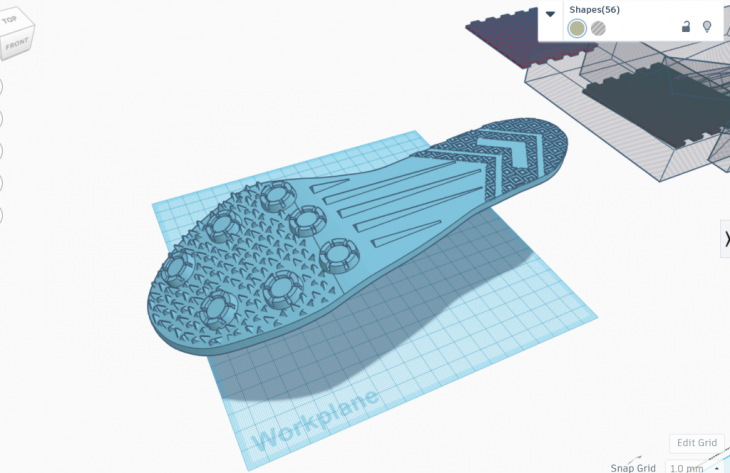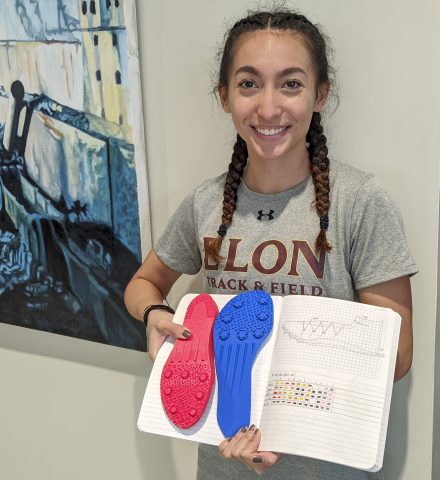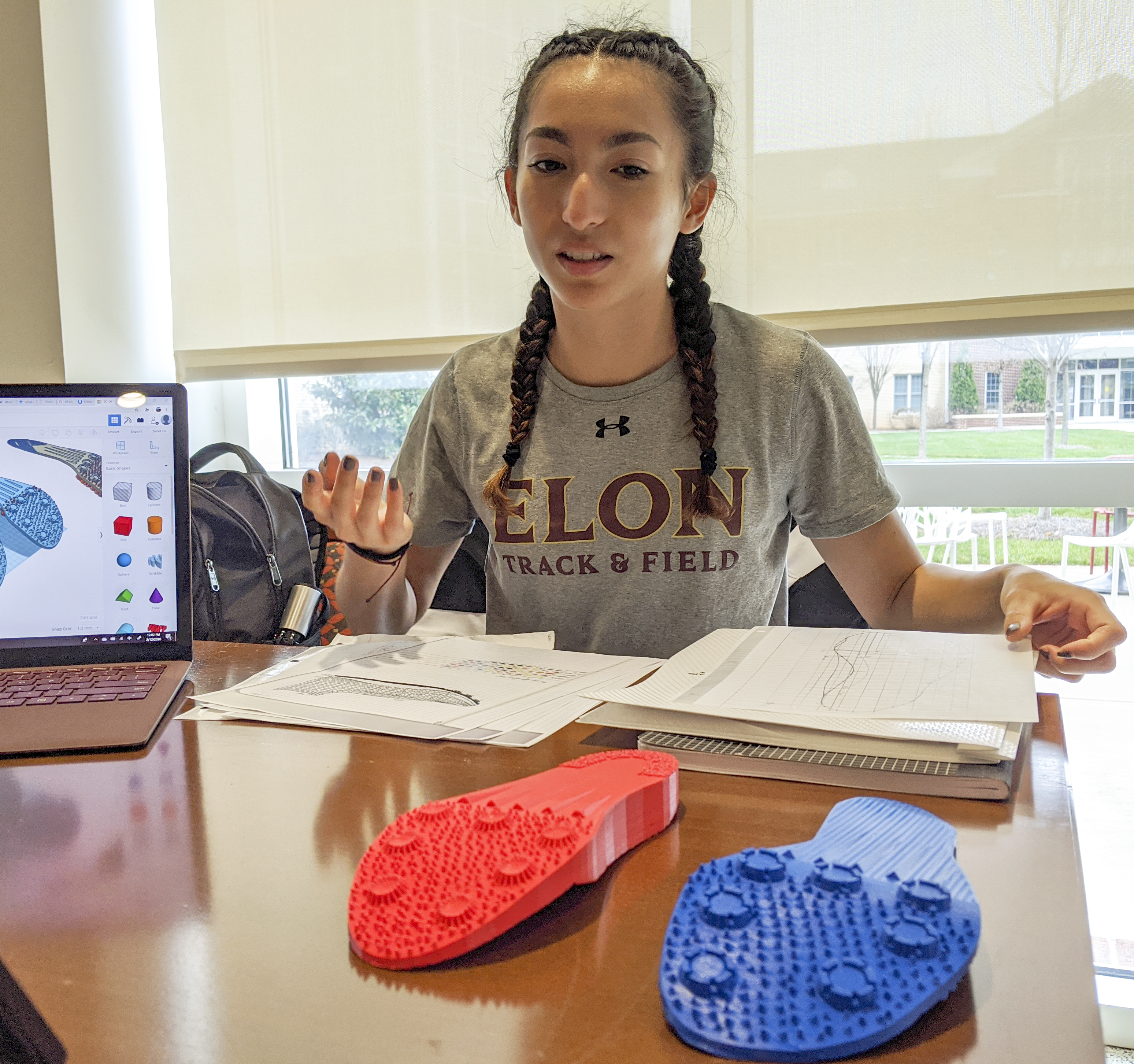Honors Fellow, engineering major and athlete Madison George '23 set out to design and prototype the first women's pole-vaulting shoe. The support of Elon faculty, staff, teammates and an alumnus has her thinking bigger.
Madison George’s ambitious engineering project began with a simple but baffling question: Why don’t they make pole-vaulting shoes for women?
The question had frustrated the student-athlete since high school, when she began competing in the Scottsdale, Ariz.-area in the ill-fitting, unisex track spikes on the market. Those shoes leave female athletes’ feet unsupported and prone to injuries.
“The first women’s pole-vaulting event at the Olympics was in 2000,” George says. “All these women in the Olympics are still wearing men-sized shoes.”
Now a first-year engineering major and Honors Fellow, she’s set out to design her perfect pole-vaulting shoe. And it doesn’t look like she’ll stop there. With the input of her Elon Phoenix teammates, she’s expanding a long-term vision to 3D-printable, customized spikes for all track and field competitors.

As you read this, a sizeable portion of Elon’s team is nursing painful shin splints. Competitive runners have come to accept them. George doesn’t think they should have to.
“Shin splints are seen as just a thing that runners have to deal with, but it doesn’t have to be that way. Why aren’t we doing more when so many are being injured?” George asked.
The solution lies in using better technology and better engineering to make better shoes.
“I could see something light up in her eyes. The next class, she came to me: ‘I’ve got this crazy idea …’ In less than a week, she’d taught herself the computer program to design it. She was already so invested in it. That’s what I love, to find a student who’s so enthusiastic about a project.”
— Kyle Altmann, associate professor of physics
The spark for George’s shoe designs began in fall 2019 when Dan Reis, the Maker Hub’s senior instructional technologist, presented the Hub’s Kickbox grant program to Associate Professor of Physics Kyle Altmann’s class. Kickbox awards $300 grants to a select number of student projects each year with the goal of encouraging them to design and build things not typically within reach. George’s was one of 20 projects selected in 2019, Reis said.
“I could see something light up in her eyes,” Altmann said. “The next class, she came to me: ‘I’ve got this crazy idea …’ In less than a week, she’d taught herself the computer program to design it. She was already so invested in it. That’s what I love, to find a student who’s so enthusiastic about a project.”
George’s design includes a narrower ball of foot than the unisex or men’s shoe, a higher arch, typical of most women’s feet, and seven spikes placed for best support and lift.

The biggest challenge facing George’s 3D printing isn’t the design. She knows what she wants, where the spikes need to be placed, the areas of the foot and arch that need the most support. Her biggest obstacle is materials. Only certain types of plastics can be 3D printed. The kind typically used in the Maker Hub printers is rigid. Her shoe will need to be flexible but strong.
“You put a lot more trust in your shoes than you think,” George said. “Imagine if you were running and your shoes just snapped. It would be catastrophic.”
Altmann and Associate Professor of Engineering Scott Wolter have been advising George through the process and on the types of materials she needs to explore.
Reis put her in touch with Connor TeVault ’16, who now works at 3D printing company Carbon. Carbon paired with Adidas to 3D print a midsole for an athletic shoe designed to transfer energy back into the feet on impact. TeVault guided her through some ideas and suggested NinjaFlex — a flexible 3D printing filament — as a material.
Wolter has expertise in materials science. After so much of Altmann’s time and help, meeting with Wolter the first time made her realize how much Elon faculty care about students, George said.
“She’s a go-getter, and what a great project. She’s championed it. She’s smart about taking input and she knows what her homework is.”
— Scott Wolter, associate professor of engineering
“I was ecstatic. He gave me all these samples of different materials. We went upstairs in one of the rooms, and he just cut me pieces of materials to work with,” George said. “I went in thinking I was going to use nylon for this, (thermoplastic polyurethane) for the upper, and NinjaFlex for this. He told me about a lot of different types of nylon and (thermoplastics) and explained their melting points, hardness, elasticity, yield strength.”
Wolter was as impressed with her enthusiasm and detailed designs as Altmann. George taught herself how to design in two different computer programs, including SolidWorks, which learning how to use is a large portion of an engineering course students typically take in the spring semester of their first year.
“She’s a go-getter,” Wolter said, “and what a great project. She’s championed it. She’s smart about taking input and she knows what her homework is.”
George, who’s already printed two prototypes for the sole of her pole-vaulting shoe, is thinking ahead.
 She’s already commissioned used spikes from her teammates so she can examine the different designs and how the shoes were manufactured. Her always churning mind is dreaming about interchangeable, customized soles for different events: pole-vaulting, the long jump, the triple jump, sprints.
She’s already commissioned used spikes from her teammates so she can examine the different designs and how the shoes were manufactured. Her always churning mind is dreaming about interchangeable, customized soles for different events: pole-vaulting, the long jump, the triple jump, sprints.
She’ll present her early design during the Maker Takeover April 29 in Moseley Hall.
“I’ll have something done by April, but I’m not going to be finished in April,” George said. “I will be working on this for a while.”



